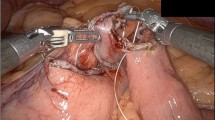Abstract
The use of stapling devices for performing gastrointestinal anastomosis has recently gained wide acceptance. In fact, since 1991, we have been using linear cutter devices for performing the Roux-en-Y anastomosis, transection of the duodenum, and closure of the jejunal stump (except following esophagojejunostomy), and are no longer employing hand-sewn procedures. In this report, the linear cutter technique used after total gastrectomy is described and the differences in anastomotic leakage, morbidity, operating time, and reconstruction time are evaluated in comparison with those following hand-sewn anastomoses. A total of 22 patients undergoing total gastrectomy within a 2-year period were randomized into two groups of 11, to have reconstruction performed by either a stapled or hand-sewn Roux-en-Y anastomosis. One patient from the stapled group died of acute myocardial infarction 6 days after the operation. Anastomotic leakages from the esophagojejunostomy region occurred in 18% of the patients in the stapled group, but fortunately no leakage was apparent from the Y-anastomosis when the linear cutter technique was used. The most obvious significance was the short mean reconstruction time in the stapled group of 19.1±3.56 min (P<0.01) being 31 min shorter than that of the hand-sewn group (n=11). Thus, we proposed that the linear cutter technique is a safe technique for performing anastomosis following total gastrectomy, which would significantly reduce the reconstruction time.
Similar content being viewed by others
References
Steichen FM, Ravitch MM (1982) History of mechanical devices and instruments for suturing. Curr Prob Surg 1:19–22
Antonsen HK, Kronberg D (1987) Early complications after low anterior resection for rectal cancer using the EEA stapling device. Dis Colon Rectum 30:578–583
Ravitch MM (1985) Intersecting staple lines in intestinal anastomoses. Surgery 1197:8–15
Bubrick MP, Corman ML, Cahill CJ, Hardy TG, Nance FC, Shatney CH (1991) Prospective randomized trial of the biofragmentable anastomosis ring. Am J Surg 161:136–143
Androsov PI (1970) Experience in the application of instrumental suture in surgery of the stomach and rectum. Acta Chir Scand 136:57–63
Steichen FM, Ravitch MM (1984) Stapling in surgery. Year book medical, Chicago, pp 220–257
Ravitch MM, Steichen FM (1972) Techniques of staple suturing in the gastrointestinal tract. Ann Surg 175:815–824
Lygidakis NJ (1981) Total gastrectomy for gastric carcinoma: a retrospective study of different procedure and assessment of a new technique of gastric reconstruction. Br J Surg 68:649–655
Viste A, Eide GE, Soreide O (1987) Stomach Cancer: A prospective study of anastomotic failure following total gastrectomy. Acta Chir Scand 1153:303–306
Inberg MV, Heinonen R, Lauren P, Antakokko V, Viikari SJ (1981) Total and proximal gastrectomy in the treatment of gastric carcinoma: A series of 305 cases. World J Surg 5:249–257
Walther BS, Oscarson JEA, Griffner HOL, Vallgren S, Evander A (1986) Esophagojejunostomy with the EEA stapler. Surgery 99:598–603
Derek DM, Taymund JD (1989) Anastomotic narrowing after esophagogastrectomy with the EEA stapling device. J Thorac Cardiovasc Surg 97:434–438
Bruno SW, Jan EAO, Hans OLG (1986) Esophagojejunostomy with the EEA stapler. Surgery 90:598–608
Author information
Authors and Affiliations
Rights and permissions
About this article
Cite this article
Shoji, Y., Nihei, Z., Hirayama, R. et al. Experiences with the linear cutter technique for performing Roux-en-Y anastomosis following total gastrectomy. Surg Today 25, 27–31 (1995). https://doi.org/10.1007/BF00309381
Received:
Accepted:
Issue Date:
DOI: https://doi.org/10.1007/BF00309381




